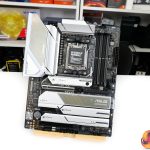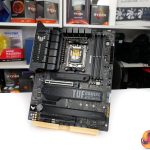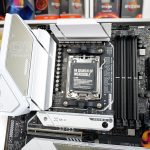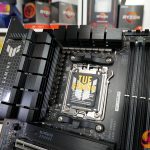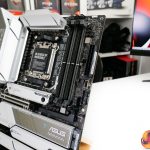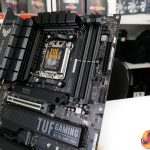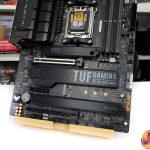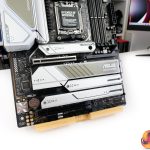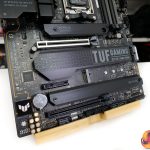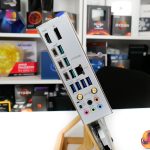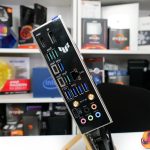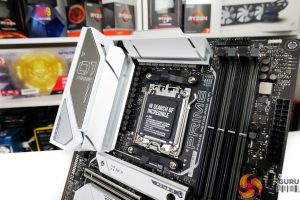Let’s start off by looking at the two ASUS motherboards that occupy a very similar price point of around £350-380 in the UK market.
ASUS’ TUF Gaming X670E-Plus WiFi and Prime X670E-Pro WiFi primarily differ by their appearance. ASUS’ Prime board goes for the usual silver/white and black colour scheme alongside a touch of RGB lighting on the rear IO cover, while the TUF Gaming alternative is dark greys and blacks.
The heatsinks focus on the logical areas very well. You get chunky pieces of metal atop the main M.2 SSD slots and the VRM components. ASUS’ Prime board focuses a little more on aesthetics of the MOSFET heatsink than the TUF Gaming option with its somewhat finned cut-outs.
Both motherboards use 8-layer PCBs and operate dual 8-pin CPU power connectors. The 14+2 stage VRM solutions are built around 70A-rated Monolithic Power Systems MPS power stages and 5K-rated capacitors.
The primary PCIe 5.0 x16 slot is steel reinforced for both motherboards. One key difference, however, is that the Prime gets ASUS’ awesome Q-release button so that you can easily remove a fat graphics card from a fully built system. Additional PCIe connectivity comes from two PCIe 4.0 x4 electrical slots, one of which is full-sized for the physical connector.
Four M.2 slots are provided by both motherboards, though the TUF board does forego one of the M.2 covers that its Prime cousin offers up. Slots 1 and 3 run from CPU lanes at PCIe 5.0 x4 and PCIe 4.0 x4, respectively. Slot 4 can do PCIe 4.0 x4 from the X670 chipset. While Slot 2 supports PCIe 3.0 x4 or SATA from the chipset, but it steals its link from the SATA ports 1 and 2 when in PCIe x4 mode. ASUS’ tool-free Q-latch design is used for connecting an M.2 SSD.
Onboard connectivity is one of the few areas where both of these motherboards differ slightly. The differences are very subtle though.
The TUF gets three ARGB and one RGB headers versus the Prime’s two ARGB and one RGB. Also, the Prime gets onboard Power and Clear CMOS buttons. You get many of the main, modern connectivity that you would want: an internal 10Gbps USB 3.2 Gen 2 Type-C header, old style USB 3.0 header, four SATA 6Gbps, triple USB 2.0 headers which is very good, and eight total 4-pin fan headers.
Both motherboards get ten total USB ports on the rear IO. These are one 20Gbps, four 10Gbps, and five 5Gbps. The TUF deploys all of its 5Gbps ports as Type-A whereas the Prime swaps one of them for Type-C.
Networking is handled by WiFi 6E and Realtek 2.5Gb Ethernet. Displayport 1.4 and HDMI 2.1 cover the video outputs, while audio is handled by a Realtek S1220A codec.
So, that’s the hands-on overview of these two ASUS X670E motherboards. There’s not much difference between them. Though I would argue that the extra rear USB Type-C port, onboard clear CMOS and power buttons, ASUS Q-release button, and added M.2 heatsink on the Prime are more valuable than the additional ARGB header on the TUF Gaming.
 KitGuru KitGuru.net – Tech News | Hardware News | Hardware Reviews | IOS | Mobile | Gaming | Graphics Cards
KitGuru KitGuru.net – Tech News | Hardware News | Hardware Reviews | IOS | Mobile | Gaming | Graphics Cards


